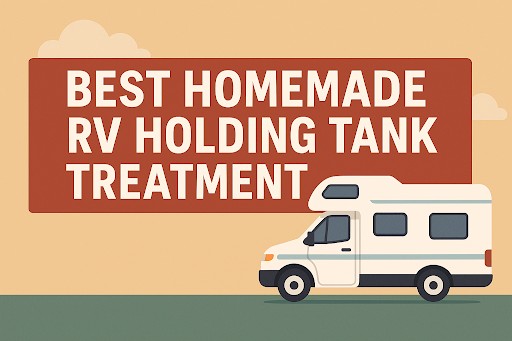Traveling in an RV brings freedom, peace, and adventure—but dealing with your RV’s holding tanks? Not so glamorous. That’s why many RVers start hunting for the best homemade RV holding tank treatment to keep things clean, fresh, and clog-free without relying on pricey chemicals.
If you’re trying to save money and maintain your tanks more naturally, this 2025 guide will walk you through the most trusted DIY treatments, step by step.
Understanding Your RV Tank System: Black vs. Gray Tanks
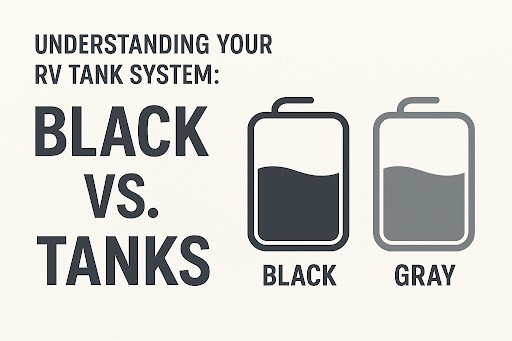
Your RV has two main waste tanks:
- Black tank: Holds toilet waste and is prone to strong odors and sensor clogs.
- Gray tank: Collects wastewater from sinks and showers. This tank often builds up grease, soap scum, and food particles.
Both tanks need care. The right treatment can prevent bad smells, keep sensors accurate, and reduce residue buildup over time.
How Tank Treatments Work: Why Water and Motion Matter
An effective tank treatment does three things:
- Reduces buildup
- Neutralizes odor
- Keeps tank sensors working properly
Water is key. Without it, solids dry out and stick to tank walls. Agitation—like driving after adding treatment—helps the mix slosh around and clean all surfaces. Cleaners dissolve waste and prevent clogs.
Comparison of Popular DIY Methods
| Treatment Method | Key Ingredients | Main Benefits | Watch Out For |
| Pine-Sol + Calgon | Pine-Sol, Calgon Bath Pearls, Water | Cleans, deodorizes, and helps sensors | Antibacterial effect may harm tank balance |
| Borax + Dawn Dish Soap | Borax, Dawn, Warm Water | Great for grease and regular upkeep | Doesn’t break down solid waste |
| Tank Bombs | Borax, Baking Soda, Citric Acid, Water | Fizzy freshener with deodorizing effects | Not strong enough for heavy solids |
What Is the GEO Method? Why RVers Still Love It
The GEO Method, a favorite among RVers since the 1980s, uses powdered Calgon, powdered laundry detergent (or Dawn), and hot water.
It’s simple: Calgon keeps waste from sticking to the tank, and the detergent cuts through grime. Some people add bleach for extra sanitation, but do so sparingly. It’s affordable and effective, especially when used consistently.
GEO Method Variations You Can Try
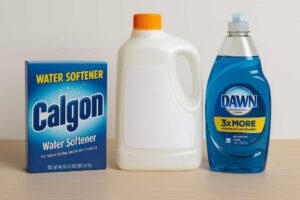
Many RVers tweak the original recipe. Some use dish soap instead of powdered detergent, or Borax instead of Calgon. Hot water is usually added to help everything dissolve.
A popular trick is to add the solution before a long drive, using road vibration to boost cleaning power. Some also adjust ingredient ratios based on tank size.
How to Use the Pine-Sol and Calgon Method
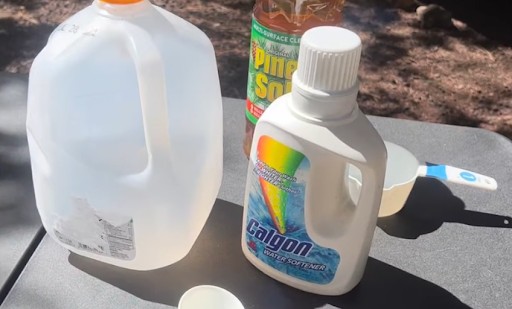
Mix 40 oz. of Pine-Sol and 8 oz. of Calgon Bath Pearls into a one-gallon jug. Fill the rest with water. After dumping your tanks, pour half a cup into the black tank and another half into the gray tank.
This combo works well for odor control and cleaning, but since Pine-Sol is antibacterial, it could interfere with commercial enzyme products. Kleen Tank also warns that overuse might create sticky buildup—so use in moderation and always with plenty of water.
How to Use the Borax and Dawn Dish Soap Method
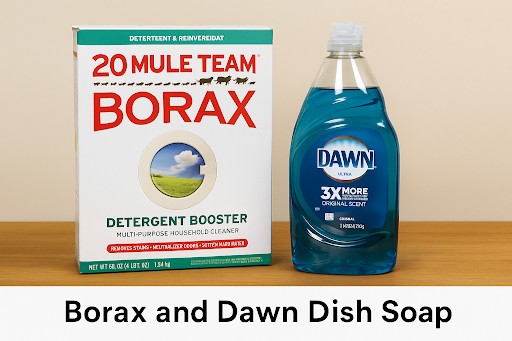
Mix 1 cup of Borax with 1/4 to 1/2 cup of Dawn dish soap in warm water. After dumping, pour it into your tanks.
Borax softens water, helping solids slide off surfaces, while Dawn breaks down grease and food particles. It’s safe, low risk, and best used before driving, so the solution can move around the tank.
This isn’t the best method for digesting solids, but it’s perfect for regular maintenance.
How to Use Homemade Tank Bombs
Make your own fizzing bombs using Borax, baking soda, citric acid, and a little water. Press into molds and let dry. Drop one into your tank after dumping, then add water.
The fizz helps loosen buildup, while the ingredients deodorize and freshen the tank. This is a great light-cleaning method between deep cleans but won’t replace enzyme-based waste digesters.
Homemade vs. Commercial Tank Treatments
| Feature | Homemade Treatments | Commercial Treatments |
| Cost | Budget-friendly, uses household items | More expensive, recurring purchase |
| Chemical Sensitivity | Free of formaldehyde and harsh additives | May include strong chemicals or fragrances |
| Sensor Safety | Gentle on sensors when used correctly | Can damage sensors if overused or not rinsed properly |
| Waste Breakdown | Limited breakdown of solid waste and toilet paper | Formulated to digest solids and paper efficiently |
| Odor Control | Effective for light odor control | Strong odor elimination with scent options |
| Maintenance Frequency | Ideal for routine, light cleaning | Better for deep cleaning or when buildup occurs |
| Environmental Impact | Typically more eco-friendly | Depends on formula; some may harm septic systems |
Many RVers choose to alternate between both methods depending on the condition of their tanks and travel needs. Many RVers alternate between both depending on their trip schedule or tank condition.
Important Safety Tips
- Never mix Pine-Sol and bleach—the combination creates dangerous fumes.
- Avoid combining homemade and commercial treatments, as they can cancel each other out.
- Dilute all ingredients properly.
- Rinse tanks thoroughly before switching methods.
Why Professional Cleaning Still Matters
Even with the best homemade RV holding tank treatment, a professional hydro-jet clean every 1–3 years helps remove deep buildup and reset sensors.
Pro services can also check your tank’s health—catching leaks or clogs before they become costly.
Best Practices for RV Holding Tank Maintenance
- Flush with water after each dump: Use at least 2 to 3 gallons of water to dilute leftover waste and activate your treatment.
- Dump only when 75% full: This creates enough pressure for a more thorough and effective flush.
- Use RV-safe products: Stick to RV-friendly toilet paper and avoid flushing wipes, paper towels, or feminine products.
- Don’t skimp on water while boondocking: Even when conserving, ensure enough water is in your tanks to keep waste from drying out and sticking.
- Winterize your tanks: In cold weather, insulate tanks and plumbing and use RV-safe antifreeze to prevent freezing.
FAQs: Quick Answers to Common Questions
What is the best homemade RV black tank treatment?
The GEO Method is the most trusted DIY option. It cleans, reduces odor, and protects sensors.
Can I use bleach in DIY treatments?
Yes, but only in small amounts—and never mix it with Pine-Sol. Use with caution.
How often should I treat my tanks?
After every dump is best. Let the mixture slosh during a drive for better coverage.
Do homemade treatments really work?
They’re excellent for cleaning and odor, but not great at dissolving solids. Use them for maintenance.
Are all household ingredients safe for tanks?
Stick to known recipes. Avoid formaldehyde, heavy bleach, or mixing unknown chemicals.
What about gray tanks?
DIY solutions like Borax and Dawn work great for gray tanks. Just pour them down the sink or shower drain.
Will these damage tank sensors or seals?
When diluted and used properly, DIY treatments are gentle and safe.
Final Thoughts: Find What Works for You
Choosing the best homemade RV holding tank treatment comes down to your lifestyle and comfort level. Try the GEO Method, Pine-Sol and Calgon, Borax and Dawn, or even tank bombs—then stick with what works.
Consistency is key. Add water, flush regularly, and clean smart. Combine your DIY efforts with the occasional professional cleaning, and your tanks will thank you.
Ready to roll? With these easy treatments, RV life just got a whole lot fresher.
